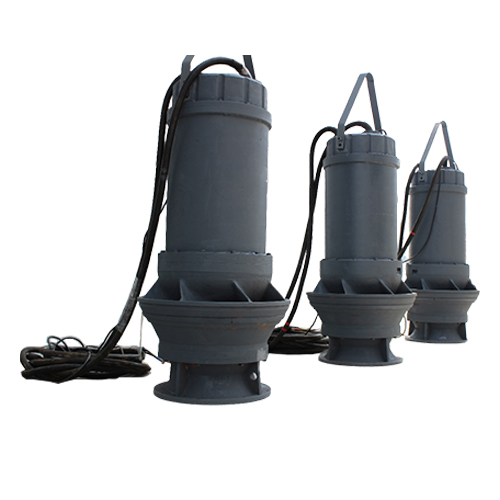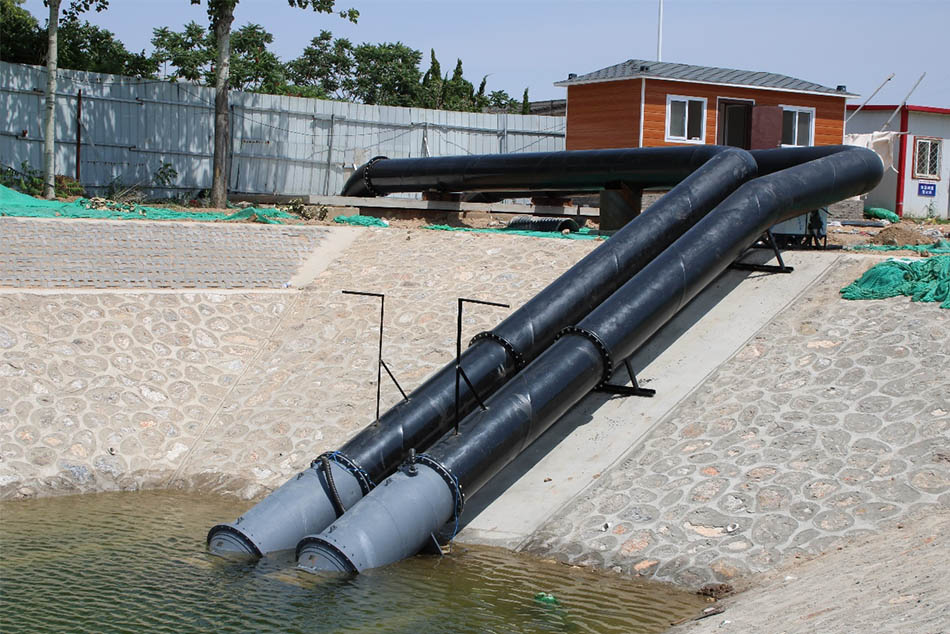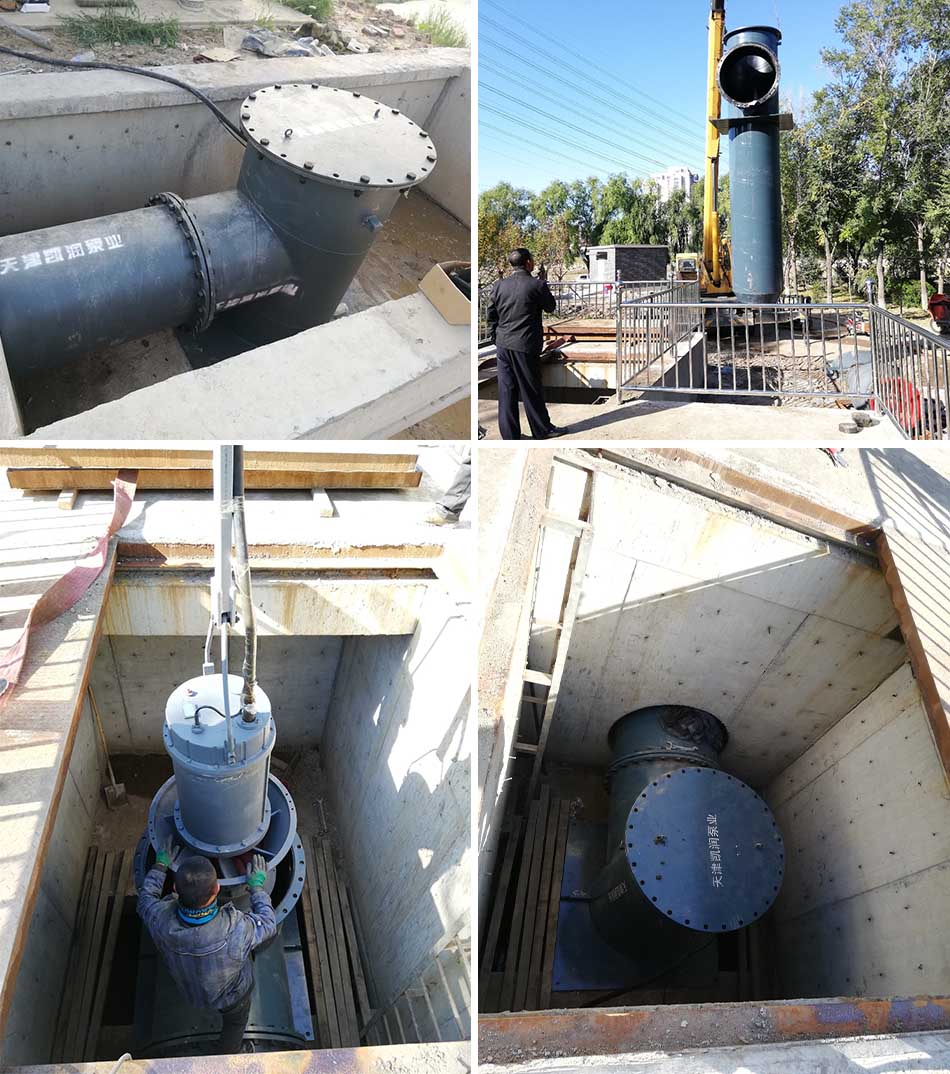Categories
Contact

Submersible Axial Flow Pumps
Submersible axial flow pumps are integral to various industries, from agriculture to wastewater management, due to their efficient fluid handling capabilities. Understanding their design, applications, and advantages can provide valuable insights into their utility and effectiveness.
How does a submersible axial flow pump work?
Submersible axial flow pumps operate with a distinct mechanism designed to efficiently manage large volumes of water. Unlike conventional pumps that utilize radial motion to push water outward, axial flow pumps function by moving water parallel to the pump shaft.
At the heart of submersible axial flow pumps lies its impeller, which plays a crucial role in the pumping process. As the impeller rotates within the pump housing, it generates centrifugal force. This force propels water through the pump along a linear path aligned with the axis of rotation. This axial movement distinguishes axial flow pumps from their radial-flow counterparts, making them particularly effective for applications that demand high flow rates at relatively low head pressures.
The design of the impeller blades is pivotal in this process. These blades are strategically shaped to optimize the interaction with water, ensuring efficient movement with minimal turbulence. This design not only enhances the pump's performance but also reduces energy consumption compared to traditional radial-flow pumps.
Submersible axial flow pumps are commonly used in various industrial and agricultural applications where large quantities of water need to be moved efficiently. Their ability to handle substantial flow rates with minimal energy input makes them indispensable in scenarios such as drainage, flood control, irrigation, and wastewater treatment.

Model | Vane Angle | Capacity (m³/h) | Head (m) | Power (Kw) | Speed (r/min) | Effciency (%) | Outer diameter of impeller (mm) |
350QZ-50 | 0° | 1173 | 10 | 55 | 1450 | 81 | 300 |
500QZ-75 | 0° | 3045 | 7 | 90 | 980 | 72 | 450 |
600QZ-100 | 0° | 3736 | 3.6 | 75 | 740 | 82 | 550 |
700QZ-100 | 0° | 4850 | 4.3 | 110 | 740 | 73 | 600 |
800QZ-50 | 0° | 6066 | 9 | 220 | 590 | 84 | 700 |
800QZ-135 | 0° | 6617 | 2.9 | 110 | 590 | 83 | 700 |
900QZ-50 | 0° | 7461 | 10 | 315 | 590 | 84 | 750 |
1000QZ-35 | 0° | 11571 | 15 | 630 | 490 | 85 | 870 |
1200QZ-50 | 0° | 12593 | 11 | 560 | 490 | 85 | 950 |
350QH-72 | 0° | 837 | 2.87 | 15 | 980 | 80 | 300 |
500QH-40 | 0° | 3200 | 16.55 | 200 | 980 | 83 | 450 |
600QH-35 | 0° | 4415 | 14.29 | 250 | 740 | 84 | 550 |
700QH-72 | 0° | 5056 | 6.54 | 160 | 740 | 84 | 600 |
800QH-72 | 0° | 6401 | 5.66 | 185 | 590 | 83 | 700 |
900QH-35 | 0° | 10791 | 14.96 | 630 | 490 | 85 | 850 |
1000QH-72 | -2° | 8871.5 | 6.09 | 250 | 490 | 85 | 870 |
1200QH-72 | +4° | 15607 | 8.45 | 560 | 490 | 86 | 950 |
1300QH-72 | +6° | 22198 | 7.79 | 710 | 370 | 85.8 | 1150 |
What are the key applications of submersible axial flow pumps?
Submersible axial flow pumps find extensive use in several critical applications where efficient water movement is essential:
Agricultural Irrigation
Submersible axial flow pumps are extensively used in agriculture to lift large volumes of water from wells, rivers, or reservoirs. They excel in irrigating expansive fields efficiently due to their capacity to handle high flow rates over long distances. Farmers rely on these pumps to ensure crops receive adequate water supply for optimal growth and yield.
Flood Control and Drainage
In urban and rural areas susceptible to flooding, submersible axial flow pumps play a crucial role in flood control and drainage systems. These pumps swiftly move substantial amounts of water from flood-prone areas to nearby rivers or drainage channels. Municipalities use them during heavy rainfall or storm events to mitigate flood risks and safeguard infrastructure and communities.
Wastewater Treatment
Within wastewater treatment plants, submersible axial flow pumps are indispensable for transporting sewage and wastewater through various treatment processes. They efficiently move large volumes of water containing solids and organic matter, ensuring effective treatment and disposal. These pumps contribute to maintaining operational efficiency and environmental compliance in wastewater management.
Aquaculture
In aquaculture operations, submersible axial flow pumps are employed to circulate and aerate water in fish farms and aquaculture ponds. They promote oxygenation and water circulation essential for the health and growth of aquatic organisms. These pumps are crucial in maintaining optimal water quality parameters to support sustainable aquaculture production.
Industrial Applications
Various industrial sectors utilize submersible axial flow pumps for processes requiring the movement of large volumes of water or fluids. Industries such as mining, construction, and manufacturing rely on these pumps for dewatering purposes, cooling systems, and process water circulation. Their robust design and high-flow capabilities make them suitable for handling demanding industrial environments.
Hydroelectric Power Generation
In hydroelectric power plants, submersible axial flow pumps are used to control water flow within reservoirs and dams. They facilitate the efficient transfer of water between different levels of the power generation system, contributing to the optimal operation and performance of hydroelectric turbines.

What are the advantages of using submersible axial flow pumps?
The adoption of submersible axial flow pumps offers several advantages over conventional pumping systems:
Efficiency
Submersible axial flow pumps are renowned for their high efficiency in moving large volumes of water. Their axial flow design minimizes hydraulic losses, resulting in optimal energy utilization and lower operational costs over time. This efficiency is particularly beneficial in applications requiring continuous or high-volume water movement, such as irrigation, flood control, and wastewater management.
Compact Design
Being submersible, submersible axial flow pumps can be installed directly into water bodies or submerged wells. This design eliminates the need for extensive above-ground infrastructure, reducing installation complexities and saving space. It also simplifies maintenance procedures since the pump remains submerged, protected from external elements and potential damage.
Versatility
Submersible axial flow pumps demonstrate versatility in handling a wide range of fluids, from clean water to heavily polluted liquids laden with solids. They maintain consistent performance across varying conditions, making them suitable for diverse environments including industrial processes, municipal water systems, and agricultural applications. This adaptability enhances their utility in environments where different types of fluid management are required.
Reliability and Durability
Built with robust materials and designed for submerged operation, submersible axial flow pumps exhibit high durability and reliability. They are less prone to wear and tear compared to surface-mounted pumps, as they are shielded from external debris and weather conditions. This reliability ensures long-term performance and minimal downtime, crucial for critical applications such as flood control, drainage, and wastewater treatment.
Noise Reduction
Submersible pumps operate underwater, which inherently reduces noise levels compared to above-ground pumps. This feature is beneficial in residential areas or environments where noise pollution needs to be minimized, ensuring quieter operation without compromising performance.







